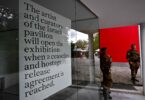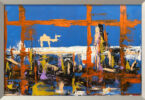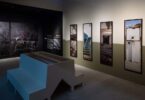Hrag Vartanian
PORTLAND, ME : If you pass by the First Avenue L street station, you will see five vibrant mosaics, placed in locations that are fully accessible to the public without the need to pay the fare — it might very well be the only New York City subway artwork series fully visible and approachable in this way. That democratic attitude permeates so much of Katherine Bradford’s work, which uses human forms and compositions as a way to organize color. At the subway station, she renders her work in glimmering form, emitting a sense of light from her paintings, as the flattened figures metaphorically swim in a sea of blues or grays — and in one case atop a field of blooming flowers. The mosaics capture many of the themes that have persisted throughout her career, namely, light, accessibility, the human body, and freedom.
Bradford’s works are luscious and visually enthralling, the current retrospective of her paintings at the Portland Museum of Art in Maine is a celebration of an artist who lives and works in both Maine and New York.

Her survey has been making waves with fans of contemporary painting up and down the eastern seaboard, which is no surprise considering Bradford is a painter’s painter in the true sense of the word. She started to establish a wider reputation, beyond her own artistic circles, with her superhero paintings. These paintings project a brisk power in the way she places her heroic figures against moody, mostly monotone backgrounds. They fly, they move, but they’re also vulnerable and not entirely heroic. Her origins as an abstract artist are still discernible in her later, better-known representational work, and that interplay is part of the pleasure of her image making.
“Woman Flying” (1999), one of the show’s earliest works, is the first superhero painting she ever made and also a self-portrait. It depicts a nude woman, but for a red Superwoman cape, flying toward us over a horizon line that appears to represent a body of water. The painting seems to unofficially bridge her Superhero and Runaway Wife or Woman series, two bodies of work undergirded by a sense of newfound freedom, represented by the optimistic palettes and fluid forms and the joy the artist clearly gets from painting. The image of the superhero, she has said in the past, is also an avatar for artists, which makes sense considering how in our culture, artists are often lionized while being gawked at and scrutinized in strange and uncomfortable ways.

That sense of freedom is part of the appeal of an artist who jokes about her inability to draw anatomically correct arms, dismisses attempts to categorize her style as self-taught or naive (she prefers the term “crude”), and explains that she never washes her brushes, which have petrified into objects when she retires them from her studio. She freely borrows and builds on the precedents of other American artists, including Marsden Hartley, Forrest Bess, Milton Avery, Philip Guston, Carroll Dunham, and dozens of others, some of whom are her colleagues; it’s also easy to see interconnections and shared interests with Rick Briggs, Chris Martin, Peter Acheson, and the other artists in her circles.
In the mid-2010s, Bradford shifted from oil to acrylic paint. The change has made her work brighter, and has allowed her to enjoy the thrill of fluorescent paint, used prominently in her recent work. Backgrounds are almost always sparse, sometimes only suggested by a horizon line, and she often shifts the perspective in such a way that you imagine you are watching swimmers from a perch in the sky or floating in outer space while superheroes zoom by. The people themselves aren’t rendered in sharp focus, like most of her forms, and they have a schematic quality that walks a line between reality and stereotype.
It wasn’t until she produced her swimmers that she started to get serious attention from an even wider audiences. Her “Fear of Waves” (2015) is a tour de force, and in its sketchy depictions of bathers she renders them immediately recognizable and visibly temperamental, like many of her most powerful works.

“Fear of Waves” (2015) was part of her “breakthrough,” as characterized by John Yau in his 2016 review of an exhibition of the same name by Bradford at Canada gallery, and it is one of the last major oil paintings she’s created. In this enthralling painting, she plays with transparency, rhythm, and the anonymity of the crowd in various ways. A chronology displayed in one small room of the exhibition notes two relevant milestones. In 2007, “The artist’s mother passes away,” and “Bradford begins to paint swimmers surrounded by water.” I find it hard to resist seeing a connection.
I have long wondered about the stiffness of some of her painted figures, often perceiving them as clumsy and mummy-like in their comportment. After seeing the First Avenue mosaics, it all made sense, as I immediately recognized the Byzantine quality that gives her work a timeless feel. The figures, anonymous and schematic (she doesn’t draw from nature or images), are vessels for color and paint. They sometimes line up; other times they embrace, or intersect with other forms in impossible configurations. I find the “human” paintings more complex than her boats and other work, though I would’ve enjoyed seeing some of the early abstract pieces that were omitted from the show.
“Lunch Painting” (2019) embodies why her figures, sometimes reduced to one brushstroke, sing so loudly on her canvases. A rambunctious meal is rendered in a way that is immediately clear to anyone who has sat at a rowdy table to enjoy a meal with others. One chair, perhaps for the artist or the viewer, remains empty, as if to invite us in. That generous spirit, refusing to fully seal painting off from new possibilities, is at the core of her work. Whether we take a seat or walk on by is our decision.
Courtesy: hyperallergic






